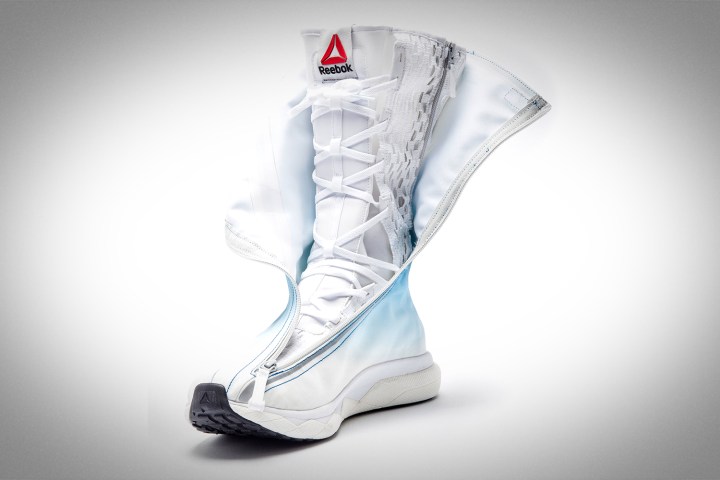
“They wanted a hybrid of a runner, sandal, wrestling boot, and aviator boot.”
Traditionally, astronauts walk around in tough leather boots with firm soles, which looked like cumbersome buckets of cement. But when Boeing sends astronauts to the ISS next year aboard its CST-100 Starliner, it wants to do better with a lightweight new spacesuit designed by the David Clark Company (DCC).
On Earth or in outer space, no suit is complete without a pair of matching kicks. So DCC partnered with Reebok to develop the Floatride SB-01. The Space Boots use Reebok’s Floatride Foam, which adds cushioning to the midsole without weighing the shoe down like a traditional midsole. It’s the same cushioning technology found in the Floatride Run shoes Reebok released in April.
With astronauts currently testing the SB-01, Digital Trends caught up with Dan Hobson — vice president of Innovation at Reebok — to find out how the final space boot came from a projectile sandal, what tests are being conducted on the Floatride SB-01, and just how much of this boot is like Reebok running shoes.
Digital Trends: Who or what inspired the idea for Reebok to get into the astronaut business?
Dan Hobson: We routinely reach out to local innovative companies to hopefully partner with and share ideas on mutually beneficial projects. Space travel is something our team has always been interested in, so we called the David Clark Company, and that’s how it started.

We’ve partnered with David Clark Company in the past; our first project with them was a running jacket utilizing space suit technologies. They then asked us if we would be invested in developing some specialized footwear for their CST-100 suit. Shane Jacobs from David Clark Company said they wanted a hybrid of a runner, sandal, wrestling boot, and aviator boot.
How did you even begin to know what it would look like?
We had no idea what it would look like. That is an amazing position to be in because then we’re designing and developing in an environment without any preconceptions of what it should be or look like. We absorbed as much information as fast as possible from Shane, and from research on space-suit design, to understand the vast array of variables and parameters we would need to take into consideration.
We started simply by putting Shane in the suit and trying various footwear on him. One of those failed trials included a minimal sandal that shot off his foot when we pressurized the suit.
We had multiple paths going simultaneously but for all of the iterations, we would make quick prototypes and test them, make modifications, and test again.
The Floatride Foam technology is central to this space boot. How will the space boot differ from the running shoes released in April with the same technology and in what ways will they be similar?
On the space boot, the rubber traction, the float foam, and the stabilizing foam that sits above the float foam are identical to the Floatride Run, so the feel underfoot will feel very similar.
“There are also some ‘easter egg’ nods to previous astronauts to be found in the boot”
The upper portion of the space boot is completely different. However, we still wanted to achieve the distraction-free ethos that we were using for the Floatride Run. The space boot uses a Nomex shell for fire resistance, and the inside uses a special mesh that stretches to a certain point, then locks out when the suit inflates, which allows the boot to always fit comfortably.
How closely did you work with David Clark?
We worked incredibly close with Shane, and there was total trust between our companies to try different iterations and give honest criticism. Early in the process, he would describe the feel, fit, and function we needed, and then we would brainstorm different ways to achieve it.
What tests are being run on the shoes by astronauts?

Obviously, lives are at risk, so spacesuit design is serious business, and testing is incredibly rigorous down to the most minute detail. Some basic tests involve climbing in and out of the CST-100 capsule, and running and jumping. Other tests involve being inside a pressurized suit and remaining in it for extended periods of time, which is uncomfortable to begin with, so the boot had to be irritation free.
How long did it take to develop the final shoe?
We started the project about two and a half years ago, and small changes are still a possibility.
Were there multiple iterations of the space boot? If so, how did you know it was right?
Yes, we had many iterations of the boot. We knew what direction was right because we tested every single iteration with Shane in the suit, pressurized and unpressurized.
It will supposedly be lighter and more comfortable, so astronauts can move quicker. Have you spoken with NASA or other companies looking to do manned space missions?
Previous astronaut footwear was built from off-the-shelf boots slightly modified, that performed adequately but was still heavy, cumbersome, and not really designed for space travel. The Space Boot is designed specifically to meet the astronaut’s needs which include being extremely light, flexible, and featuring a very high level of comfort. Our plan is to continue to work with DCC on future space programs. DCC already develops suits for NASA and other companies.
How did you get to the final look of the boot?
It was definitely function first but we knew that we wanted something that visually integrated seamlessly into the suit, and still had a clean, very modern aesthetic like the Floatride Run. There are also some “Easter egg” nods to previous astronauts to be found in the boot, if you know what you are looking for.


